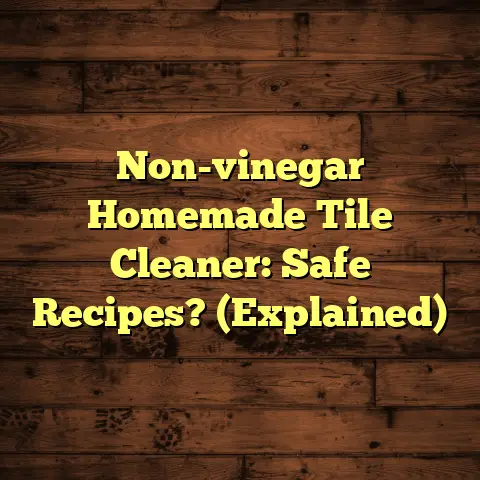How to Apply Tile Adhesive? (4 Mortar Mistakes!)
Ever walked into a room and been wowed by the tile work? A flawlessly laid tile floor isn’t just about aesthetics; it’s about adding value, durability, and a touch of personality to your space. I’ve seen firsthand how a successful tiling project can completely transform a room, and trust me, the feeling of accomplishment when you step back and admire your work is priceless.
But let’s be real, tiling can be intimidating. That’s where understanding tile adhesive, also known as mortar, comes in. It’s the unsung hero of any tiling project. Get it right, and your tiles will last for years. Get it wrong, and you’re looking at cracks, loose tiles, and a whole lot of frustration.
In this article, I’m going to walk you through everything you need to know about applying tile adhesive. We’ll cover the different types, how to prepare, the step-by-step application process, and, most importantly, the common mistakes you need to avoid. So, grab a cup of coffee, and let’s get started!
Section 1: Understanding Tile Adhesive
So, what exactly is tile adhesive? Simply put, it’s the glue that holds your tiles to the substrate (the surface underneath). It’s a crucial component, acting as a bonding agent that ensures your tiles stay put, even under stress and moisture.
Think of it like this: you wouldn’t build a house with flimsy nails, right? The same goes for tile adhesive. You need the right type for the job.
There are several types of tile adhesives available. Here’s a quick rundown:
-
Thin-Set Mortar: This is the most common type of tile adhesive. It’s a cement-based powder that you mix with water or a latex additive. Thin-set is incredibly versatile and works well with most types of tiles, including ceramic, porcelain, and some natural stones. It comes in different grades, like modified and unmodified, which we’ll discuss later.
-
Mastic: Mastic is a pre-mixed adhesive, which makes it convenient for smaller projects. It’s typically used for wall tiles in dry areas. I generally don’t recommend it for floors or wet areas because it’s not as water-resistant as thin-set.
-
Epoxy Mortar: This is a two-part system that consists of a resin and a hardener. When mixed, it creates a super strong and chemical-resistant bond. Epoxy mortar is ideal for demanding environments like commercial kitchens, hospitals, and areas exposed to harsh chemicals. It’s also great for glass tiles and some natural stones that are sensitive to moisture.
Choosing the right adhesive is critical. Consider these factors:
-
Type of Tile: Different tiles have different requirements. For example, large format tiles often require a modified thin-set mortar for better flexibility and adhesion. Glass tiles might need a white thin-set to prevent discoloration.
-
Substrate: Is your substrate concrete, plywood, or drywall? Each material requires a specific type of adhesive. For example, plywood requires a flexible thin-set to accommodate movement.
-
Environment: Is the area wet or dry? A shower or bathroom floor needs a water-resistant adhesive like a modified thin-set or epoxy mortar.
A good tile adhesive should have these properties:
- Flexibility: The ability to withstand movement without cracking.
- Durability: Long-lasting performance under normal wear and tear.
- Moisture Resistance: Protection against water damage, especially in wet areas.
- Bond Strength: A strong bond to both the tile and the substrate.
- Workability: Easy to mix and apply.
Section 2: Preparing for Tile Adhesive Application
Before you even think about opening that bag of mortar, proper preparation is key. I can’t stress this enough: a well-prepared surface is half the battle. Skimp on this step, and you’re setting yourself up for problems down the road.
First, substrate preparation is paramount. This involves:
-
Cleaning: Remove any dirt, dust, grease, or old adhesive. I recommend using a shop vacuum and a good degreaser. For stubborn residues, a scraper might be necessary.
-
Leveling: Ensure the surface is flat and even. Use a self-leveling compound for concrete floors or shims for plywood subfloors. I often use a long level to check for any dips or humps.
-
Priming: Apply a primer to improve adhesion. Primers create a better bond between the adhesive and the substrate. Choose a primer that’s compatible with your adhesive and substrate.
Next, gather your tools and materials. Here’s a checklist:
- Tile Adhesive: Choose the right type for your project.
- Mixing Bucket: A clean bucket for mixing the mortar.
- Mixing Paddle: A drill-mounted mixing paddle for efficient mixing.
- Trowels: Different notched trowels for different tile sizes.
- Spacers: To ensure consistent grout lines.
- Level: To check for levelness during installation.
- Rubber Mallet: To gently tap tiles into place.
- Sponge: For cleaning excess adhesive.
- Safety Glasses: Protect your eyes from dust and debris.
- Gloves: Protect your hands from the adhesive.
- Knee Pads: Trust me, your knees will thank you.
Finally, plan your tile layout. This is where you decide how the tiles will be arranged.
- Measure: Measure the area to be tiled and calculate the number of tiles needed. Add about 10% for cuts and breakage.
- Dry Layout: Lay out the tiles without adhesive to visualize the final result. This will help you identify any potential problems, like awkward cuts or uneven spacing.
- Reference Lines: Use a chalk line to create reference lines that will guide your tile placement. I usually start with a center line and work outwards.
Section 3: Step-by-Step Guide to Applying Tile Adhesive
Alright, let’s get to the fun part! Here’s a detailed, step-by-step guide to applying tile adhesive:
Step 1: Mixing the Adhesive
This is where many DIYers go wrong. The consistency of the mortar is crucial. Too wet, and it won’t provide enough support. Too dry, and it won’t bond properly.
- Read the Instructions: Always read the manufacturer’s instructions on the bag. They’ll specify the correct water-to-mortar ratio.
- Add Water Gradually: Pour water into the mixing bucket, then slowly add the mortar while mixing with a drill-mounted paddle.
- Mix Thoroughly: Mix for several minutes until you achieve a smooth, creamy consistency. It should resemble peanut butter or cake frosting.
- Let it Slake: Allow the mixture to “slake” for about 5-10 minutes. This allows the chemicals to fully activate. Then, remix briefly before using.
Step 2: Spreading the Adhesive
Choosing the right trowel is essential. The size of the notches determines the amount of adhesive applied.
- Trowel Size: Use a trowel with notches that are appropriate for the size of your tiles. Larger tiles require larger notches. As a general rule, use a ¼” x ¼” x ¼” notched trowel for tiles up to 6″ x 6″, a ¼” x 3/8″ x ¼” for tiles up to 8″ x 8″, and a ½” x ½” x ½” for tiles larger than that.
- Apply Evenly: Hold the trowel at a 45-degree angle and spread the adhesive in a consistent, even layer.
- Comb the Mortar: Use the notched side of the trowel to create ridges in the adhesive. These ridges provide channels for air to escape when you press the tile into place, ensuring a strong bond.
- Work in Small Sections: Only spread enough adhesive for a few tiles at a time. Mortar can dry out quickly, especially in warm weather.
Step 3: Setting the Tiles
Now for the moment of truth!
- Place the Tile: Carefully place the tile onto the adhesive, aligning it with your reference lines and spacers.
- Press Firmly: Press the tile firmly into the adhesive, using a slight twisting motion. This helps to create a good bond.
- Check for Levelness: Use a level to ensure the tile is flush with the surrounding tiles.
- Tap with a Rubber Mallet: Gently tap the tile with a rubber mallet to set it in place and eliminate any air pockets.
- Use Spacers: Insert spacers between the tiles to maintain consistent grout lines.
Step 4: Cleaning Excess Adhesive and Ensuring Even Coverage
- Remove Excess Adhesive: Use a damp sponge to wipe away any excess adhesive from the tile surfaces and grout lines.
- Check Coverage: Periodically lift a tile to check the coverage of the adhesive. You should have at least 80% coverage for dry areas and 95% coverage for wet areas. If the coverage is insufficient, use a larger notched trowel or apply more pressure when setting the tiles.
Section 4: Common Mortar Mistakes and How to Avoid Them
Okay, let’s talk about the pitfalls. I’ve seen it all in my years as a flooring contractor. Here are four common mistakes that DIYers make when applying tile adhesive, and how to avoid them:
Mistake 1: Using the Wrong Type of Adhesive for the Tile or Substrate
This is a big one. As we discussed earlier, different tiles and substrates have different requirements. Using the wrong adhesive can lead to:
- Poor Adhesion: The tiles might not bond properly to the substrate.
- Cracking: The adhesive might not be flexible enough to accommodate movement.
- Water Damage: The adhesive might not be water-resistant enough for wet areas.
How to Avoid It:
- Do Your Research: Carefully research the requirements of your tiles and substrate.
- Consult a Professional: If you’re unsure, consult a flooring contractor or a knowledgeable salesperson at a tile store.
- Read the Label: Always read the manufacturer’s instructions on the adhesive packaging.
Mistake 2: Inadequate Surface Preparation Leading to Poor Adhesion
As I mentioned earlier, proper surface preparation is crucial. Failing to clean, level, or prime the surface can lead to:
- Weak Bond: The adhesive won’t bond properly to a dirty or uneven surface.
- Loose Tiles: The tiles might come loose over time.
- Uneven Surface: The finished floor might be uneven and unsightly.
How to Avoid It:
- Clean Thoroughly: Remove all dirt, dust, grease, and old adhesive.
- Level the Surface: Use a self-leveling compound or shims to create a flat and even surface.
- Prime the Surface: Apply a primer to improve adhesion.
Mistake 3: Incorrect Mixing Ratios Resulting in Improper Consistency
The consistency of the mortar is critical. As we discussed earlier, mortar that’s too wet or too dry won’t perform properly. This can lead to:
- Poor Support: Wet mortar won’t provide enough support for the tiles.
- Weak Bond: Dry mortar won’t bond properly to the tiles or substrate.
- Cracking: Improperly mixed mortar can crack over time.
How to Avoid It:
- Read the Instructions: Always read the manufacturer’s instructions on the bag.
- Measure Carefully: Use a measuring cup or scale to ensure the correct water-to-mortar ratio.
- Mix Thoroughly: Mix for several minutes until you achieve a smooth, creamy consistency.
- Let it Slake: Allow the mixture to “slake” for about 5-10 minutes, then remix briefly before using.
Mistake 4: Skipping the Curing Time Before Grouting or Foot Traffic
Tile adhesive needs time to cure properly. Rushing this process can lead to:
- Loose Tiles: The tiles might shift or come loose if you grout or walk on them before the adhesive has fully cured.
- Cracking: The adhesive might crack if it’s subjected to stress before it’s fully cured.
How to Avoid It:
- Read the Instructions: Always read the manufacturer’s instructions on the adhesive packaging.
- Allow Sufficient Curing Time: Typically, you should wait at least 24-72 hours before grouting or walking on the tiles. The exact curing time will depend on the type of adhesive and the environmental conditions.
Section 5: Final Thoughts on Tile Adhesive Application
We’ve covered a lot of ground in this article, from understanding the different types of tile adhesives to avoiding common mistakes. The key takeaways are:
- Choose the right adhesive for your project.
- Prepare the surface properly.
- Mix the adhesive to the correct consistency.
- Apply the adhesive evenly and consistently.
- Allow sufficient curing time.
Proper tile adhesive application is essential for a beautiful and lasting tile installation. By following these guidelines, you can avoid costly mistakes and achieve professional-looking results.
Conclusion
DIY home improvement projects can be incredibly rewarding. There’s nothing quite like the satisfaction of transforming your space with your own two hands. With careful planning, attention to detail, and the knowledge you’ve gained from this article, you can approach your tiling project with confidence.
So, what are you waiting for? Start your transformative journey today! Your dream tile floor is within reach. Go ahead, grab your tools, and create a space you’ll be proud of for years to come. You’ve got this!





